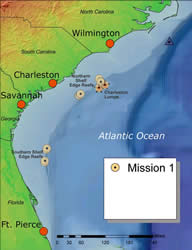 |
|
 |
|
Throughout the video investigation tool you will find still images that link to video clips. To view a video clip, simply click on a still image, and allow ample time for the file to download. If you are going to use the Assessment section, please do so after viewing the entire site. To receive the Assessment’s answer key, which includes the attributes of each video clip, please send an e-mail request to the address found on the assessment page. We welcome your comments and feedback at oceanica@cofc.edu. While using this video investigation tool the student is encouraged to track their discoveries by setting up a data table. The table for this site should include the three main categories: the main identifiying characteristics, substrate type, and organisms present. From here it is the students’ responsibility to record the observations they feel are important. This open-ended format helps to foster a more creative scientific learning method for the student. |
Dr. Leslie R. Sautter Project Oceanica Director Associate Professor Department of Geology and Environmental Geosciences, College of Charleston |
Paul Korchari Graduate Student MES Program, Biology, College of Charleston NSF GK-12 Fellowship |
Mary O'Leary Science Teacher Sch. of Math & Science, Charleston, SC NSF GK-12 Fellowship |
Dewey Golub Project Oceanica Webmaster Technology Specialist College of Charleston |
|
NSF grant funded GK-12 #502448 (Tempel, G. and VanSickle,
M., co-PIs)
|
|||
|
Ph. 843-953-7846 |
Project Oceanica Dept. of Geology & Environmental Geosciences College of Charleston, Charleston, SC 29424 |
Fax 843-953-7850 |
 The
main goal of this video investigation resource is to facilitate inquiry-based
learning through activities that require the scientific skills of observation,
data collection, comparison, and analysis. The video clips that accompany
the descriptions of each reef site are provided to allow students the
opportunity to observe the reefs and record descriptions to better recognize
them. By allowing students to analyze the reef sites on their own, they
will develop skills of observation and visual data collection. Educators
may wish to have students develop a data table listing the different
characteristics important in identifying the various reef sites. The
Assessment videos provide students the opportunity to use their data
table to determine the site to which the reef belongs. The goal behind
focusing the web site on inquiry-based learning is to facilitate the
students in discovering science By allowing them hands-on access to
the activities, they develop scientific skills and interest in a more
personal way and they will better understand what it is to participate
in science.
The
main goal of this video investigation resource is to facilitate inquiry-based
learning through activities that require the scientific skills of observation,
data collection, comparison, and analysis. The video clips that accompany
the descriptions of each reef site are provided to allow students the
opportunity to observe the reefs and record descriptions to better recognize
them. By allowing students to analyze the reef sites on their own, they
will develop skills of observation and visual data collection. Educators
may wish to have students develop a data table listing the different
characteristics important in identifying the various reef sites. The
Assessment videos provide students the opportunity to use their data
table to determine the site to which the reef belongs. The goal behind
focusing the web site on inquiry-based learning is to facilitate the
students in discovering science By allowing them hands-on access to
the activities, they develop scientific skills and interest in a more
personal way and they will better understand what it is to participate
in science.